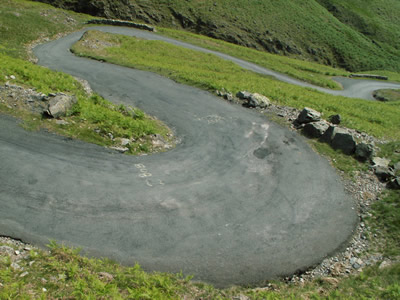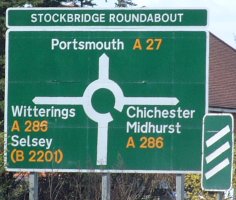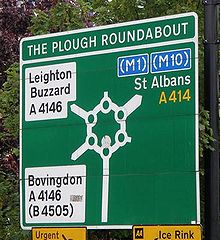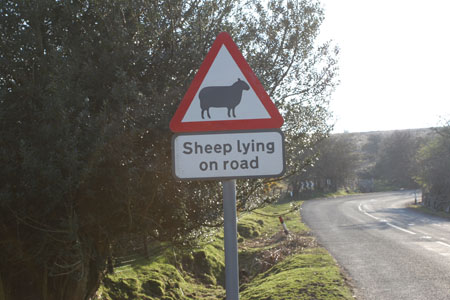If'n I had me a Hammer...
Roads
Main -- House -- History -- Cornwall -- Getting There -- On the Road -- The Roads -- London -- The Far West -- Boring Details -- Updates
Oh, British roads. What is there to say?
 |
 |
The picture on the left, fortunately for you, is way up in the north of England. But the one on the right is -- we kid you not -- the main thoroughfare through a lovely town in Cornwall called Mevagissey. We learned this when, on a visit to the town, we congratulated ourselves for having parked in a car park on the fringe of the town center rather than driving right through town, like all these idiots we saw. Our self-congratulatory spirit was somewhat dampened when we realized that the only path possible, on leaving the car park, was to drive exactly where all those idiots were driving. Oops. On our way back through, we wound up in a fascinating traffic puzzle where a line of cars had to pass by another line of cars despite there being not more than about half an inch of spare room when cars sat abreast in the street, and that only at the wider points.
That's part of the strange reality that is British driving. It isn't impossible. Brits do it all the time. But it's not Route 66 and it will take a bit of getting used to. Best way to start: rent the narrowest car you can find. And then stay calm and be ready to be patient and careful.
Roundabouts:
The "STOP" sign is a rare thing in Britain, and the traffic light, while common, is not so universally used as in the USA. Instead, a very large number of road intersections in Britain are "roundabouts," similar to traffic circles. Before each roundabout is a sign graphically depicting the roundabout and its various exits, and it's important to give that sign a glance before you wind up taking the wrong turn. One of the odder features of the signage is that, instead of saying things we would say like "A30 West," the signs usually name a town, and if you don't know the local towns you'll sometimes have no idea at all which way to go. The British road sign standards require the choice of which town to name on these signs to be based not so much upon the town's importance or size, but mostly upon the humor (sorry, "humour") value of its name, so expect lots of signs to "Leighton Buzzard" or "Drax" or "Snaith" or "Yelling" and not so many telling you which way back to London, or Bristol, or Manchester. It's very handy, when you're trying to work out where the hell Snaith is, to have a navigator in the passenger seat with a map always at the ready.
Here's a typical roundabout sign:

And here is a sign for a kind of super-roundabout, created by people of a devious and twisted sort. It turns out that while it is possible to enter and to exit this roundabout, one needs a basic understanding of quantum superstring theory to do so:

And yes, that's Leighton Buzzard on the sign. That shouldn't be surprising, as the British have, or should have, a saying: "all roads lead to Leighton Buzzard." Except in the West Country, where they all lead to Devizes. Good beer in Devizes. Go there and drink a Waddy's 6X.
When you have figured out which way you want to come out of the roundabout, life is fairly simple. People outside the circle yield to people already in it (unless, of course, lights or signs indicate otherwise). The left lane going in is sometimes only for those taking the immediate exit, so be careful how you go in. And, if you miss your exit, don't forget that you can always go around one more time, just like Chevy Chase (link will open in a new window).
What you may not expect is this: even tiny intersections will sometimes be roundabouts. There'll be a little white dot in the middle of the road, around which the not-so-round circle runs. So, yield to those coming in from your right...
Rural Roads:
If an American municipality maintained such roads as are seen in parts of the English countryside, it would be reduced to bankruptcy by the claims arising out of the accidents that would be caused. Sightlines are bad to nonexistent. Roads frequently narrow to points too tight for one car to pass alongside another, and that's when the road isn't already that narrow for its whole run. Many roads in rural areas are one-lane affairs, with occasional slight widening points which allow one to squeeze by another vehicle--and the other vehicle you meet may be an enormous tractor. You'd pull off onto the shoulder, if there were one, but as often as not the edge of the road is marked by a hedgerow, a stone wall, or a mud berm (how DO they get these roads to drain?). The road may bank in any direction; it may have a crown or it may itself be something of a ditch; it may come to a steep side edge with no guiderail in sight. It may head into the center of a medieval town that was built with a lane no wider than needed for a horse and small cart, which now handles large lorries. The locals know these roads, and their twists, wide points, and other quirks, well, and they drive faster than you would expect on them. The upside? By the end of your trip you will know EXACTLY how wide your car is.
And hazards--well--there are the usual ones, and the special ones.

British road signage can also be expected to contain a certain amount of dry humor (oops, again, "humour"). Warning signs do not necessarily help you in any way and may merely be intended to raise your blood pressure or cause that certain sense of futile resignation which is uniquely British. "Oncoming Vehicles in Middle of Road" is a favorite. Also, if you ever drive for a mile or two down a road so narrow you can't believe they allow bicycles on it, expect to arrive at a point where you are warned "Road Ahead Not Suited for Wide Vehicles." You'll see center lines in roads like that, too, for those two-foot-wide cars that elves presumably drive invisibly down country lanes. You may wish to scream, but eventually you will realize that it is an elaborate joke and you are intended to laugh.
Being well rested, and having a narrow car, and always expecting a sudden emergency stop, are very helpful things. After a while your blood pressure will indeed return to normal. But when planning a route, if you haven't already built up some experience in this, it's a good idea to try to favor a more round-about path on larger roads rather than take the straightest path. If your map book seems to suggest one route and your sat-nav unit knows a shortcut, take a deep breath before deciding. And remember that the sat-nav doesn't have to drive the damned car.
And, when you're back in the house, having a glass of sherry or a pint of brown ale, it's something interesting to think about. We are accustomed to easier driving because we are willing to pave a lot more of what surrounds us and knock through more of what's in the way, and there is something to be said for the minimalist approach and its lower impact on the landscape. But that's when you're back in the house; on the road, expect it to make you just a little bit nuts.